| Please access the following URL if you want to secure using SSL. All pages in the site will be secure pages. |
https://secure02.blue.shared-server.net/www.fish-food.co.jp/message english 4.2022.html |
Welcome to FISH FOOD TIMES
Apr. 2022 issue No.220

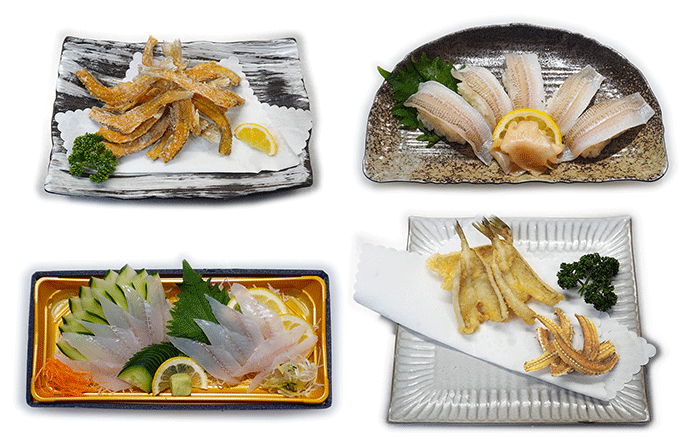
Japanese whiting dishs
Japanese whiting is spring rather than summer
Japanese whiting, which had moved to the depths of the sea during the winter season, approached the coastal area in the spring to activate feeding behavior and began preparing for the summer spawning season. For this reason, the best season for Japanese whiting fishing is from early summer to early autumn, mainly in the summer, and fishing enthusiasts will be able to enjoy easy fishing of Japanese whiting by throwing fishing on embankments and sandy beaches.
The spawning season of Japanese whiting is a multi-spawning fish that lays eggs dozens of times from June in early summer to September in early autumn. It is presumed that the most delicious time is from spring to early summer.
It is not true that a lot of Japanese whiting is sold at the fish counter before the summer spawning season. Even in the height of summer when the catch as a coastal fish is supposed to reach its peak, I feel that it is very rare to see Japanese whiting sold as whole fish in the fish counter recently.
Instead, what is sold at the fish counter is the frozen open sillago, mostly imported from Southeast Asia's Thailand and Vietnam. The frozen opening sillago has an IQF of 550g, and 30 fish is about 1,000 to 1,500 yen, so you can calculate it as 30 to 50 yen per fish, which is a convenient material for tempura. Most of the kisuten in the tempura set meal of a general Japanese restaurant should use these, and if there is a Japanese restaurant that can order sillago's bone rice cracker, it is probably a full-fledged luxury Japanese food. There is no doubt that it is a store.
This is because the Japanese whiting, which is a fresh fish landed in Japan, is stable at a high price as a high-class fish as shown in the graph below. This is because Japanese whiting is mainly for the japanese restaurant, and this fish has a slightly higher threshold for the general public.

However, Japanese whiting is one of the representative coastal fish that is often caught in Japan, and is a representative fish of Japan named English whiting and scientific name Sillago japonica. I feel sorry that this fish does not line up in the fish section in the form of a round fish at all.
Breaking the stereotypes of Japanese whiting dishes
This image is the Sillaginidae family Sillago genus whiting, which may not be unusual for anglers.

The reason why this Japanese whiting does not line up in the fish counter is not only because the purchase price is high. For general customers, it is possible that "Japanese whiting has a small fish body for its high price, and it has a high hurdle to make it into an open fish by yourself as a tempura material, and other than that, I do not know how to eat it deliciously." For that reason, it seems that the person in charge of the fish counter does not feel like buying and selling Japanese whiting, and it is difficult for the fish counter to display it.
Speaking of fish whiting, only the common sense platitude called tempura walks alone, and it seems that there is a stereotype that there is no room for other cooking ideas. So, in this month's issue, I'd like to introduce some tips for loosening and softening this rigid idea. But this is by no means an outrageous idea, just a slight deviation from common sense.
For that purpose, let's start with the process of making tempura dane, which is common sense.
| Japanese whiting tempura dane work process | |
|---|---|
 |
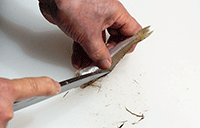 |
| 1,Scrape the scales. | 8,Remove the dorsal fin. |
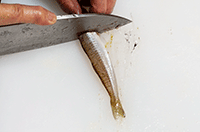 |
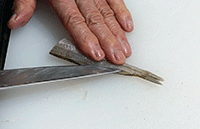 |
| 2,Cut off the head. | 9,Make a cut in the back body of the lower body and cut open the top of the central bone toward the head. |
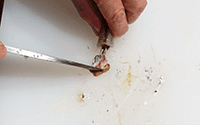 |
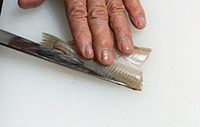 |
| 3,Scrape off the internal organs with the tip of a kitchen knife. | 10,Make a cut in the back body of the upper body and cut open the top of the central bone toward the tail. |
 |
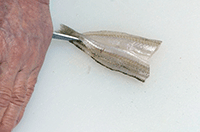 |
| 4,Scrape the rest of the internal organs, such as chiai meat of fish, with a tool such as a toothbrush. | 11,At the end of the tail, raise the knife, hold the peak of the knife with your left hand, and cut off the central bone. |
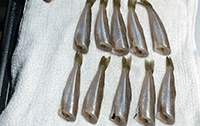 |
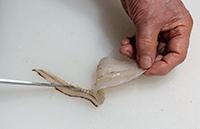 |
| 5,Arrange the processed Japanese whiting on a dry towel. | 12,Lift the open body toward the head and separate it from the central bone. |
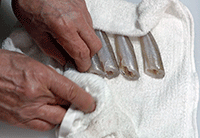 |
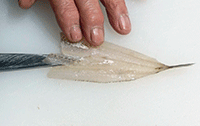 |
| 6,Cover the surface of the fish with a towel and wipe off the water, and wipe off the rest of the internal organs with a towel. | 13,Use the sori part of the knife, and cut it off in a way that scoops the abdomen. |
 |
 |
| 7,Remove anal fin. | Japanese whiting tempura tane |
Next is the sashimi work process.
| Work process of Japanese whiting tanzaku tukuri sashimi. |
|---|
 |
| 1,Make three pieces disassembling by the method of daimyo oroshi. |
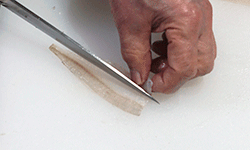 |
| 2,Remove the abdominal bone so that the chiai bone of fish is also cut off. The body becomes a little thin, but the texture does not make you feel small bones. |
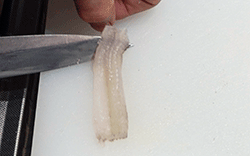 |
| 3,Remove the skin. |
 |
| 4,For small fish, uchibiki is easier to do skinning work than sotobiki. |
 |
| Japanese whiting tanzaku tukuri sashimi |
|
| Japanese whiting seared sashimi work process. |
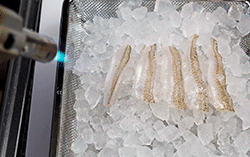 |
| 3,Boil the three pieces disassembling with skin on icebreaker. |
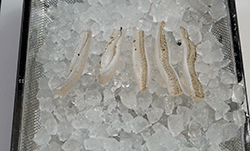 |
| 4,Leave it for a while and then cool the browned three pieces disassembling. |
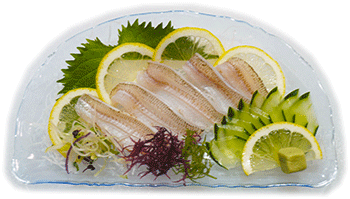 |
| Japanese whiting seared sashimi |
Next is nigiri sushi.
| Work process of Japanese whiting nigiri sushi with hot water frost. |
|---|
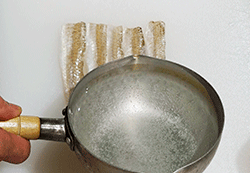 |
| 1,Pour hot water over the three pieces disassembling with skin. |
 |
| 2,As soon as the skin is warped, cool it under running water. |
 |
| 3,After cooling to some extent, wrap the top and bottom with absorbent paper to remove the water. |
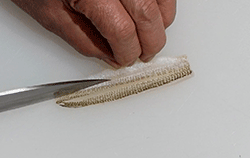 |
| 4,Make a vertical decorative cut on the hot water frosted skin. |
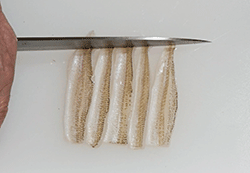 |
| 5,Line up only the upper or lower body, or the body in the same direction, and trim only the tail. |
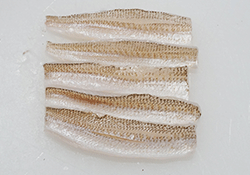 |
| 6,For the lower body with hot water frost, only the tail is trimmed. |
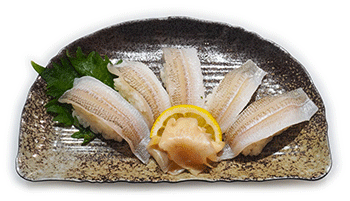 |
| Japanese whiting nigiri sushi with hot water frost |
Finally, the tempura work process begins. Here, I would like to introduce that even if you use a convenient standard product called frozen open sillago, it is impossible to realize it, and you can not see it unless you purchase the round fish whiting as fresh fish.
| Japanese whiting tempura and bone rice cracker | |
|---|---|
 |
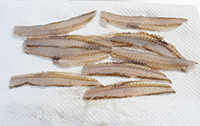 |
| 1,Japanese whiting cut open along the back | 1,After making three pieces disassembling, drain the remaining central bone with kitchen paper, lightly salt and pepper, and sprinkle with potato starch. |
 |
 |
| 2,Prepare tempura batter and cold water. | 2,The first time is 160 ° C for about 15 minutes, and the second time is 180 ° C for about 2 minutes. |
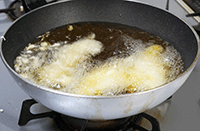 |
 |
| 3,Fry in oil at 170 ° C for 2-3 minutes. | 3,Drain the oil with kitchen paper. |
 |
|
| Assortment of Japanese whiting tempura and bone rice cracker | |
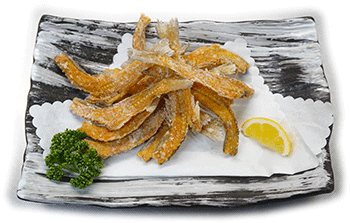 |
|
| A dish with a lot of bone rice crackers | |
Merits and demerits of trade-offs
Speaking of bone rice crackers, the most well-known are horse mackerel and eel. The author loves the bone rice cracker served at the eel shop, and I'm not satisfied with the sticking out in a small plate, so I like to make additional orders. Also, I never thought that the bone cracker of horse mackerel was as delicious as the eel, but I think that this whiting bone rice cracker is as good as the eel bone rice cracker.
When I ate the assortment of Japanese whiting tempura and bone rice cracker in the above image, I felt that the bone rice cracker was more delicious than the tempura, and I thought that the volume of the bone rice cracker was not enough. Therefore, I thought that I needed a lot of bone rice crackers like the one in the image below. The bones of Japanese whiting are not very hard, so they are just right for bone rice crackers, and their size is not too long as eels and not too wide as horse mackerel, which is just a reasonable hardness and size.
Food maker-manufactured sillago bone rice crackers are also available on the market, but they also seem to use similar sillagos from the whiting family imported from Thailand and Vietnam, similar to frozen open sillago. It is a freeze-dried product that uses dried bones to prolong the expiration date, and is a processed food in a completely different world from the dish in which the central bone of juicy whiting with good freshness is fried twice.
In other words, it is a prerequisite to cook whole fresh fish to be able to taste this exquisite bone rice cracker. For this reason, it is limited to those who use anglers who can enjoy sillago fishing or fish stores that have a wide selection of whiting. Even so, how many people know the deliciousness of Japanese whiting bone rice crackers?
For example, it has only been seven or eight years since I learned about the deliciousness of "beef motsunabe," which is one of Hakata's specialty dishes. There are various types of beef motsunabe, and if you use the expensive "non-frozen internal organs of Wagyu beef", the world of taste will change. I lived without knowing it for a long time, and after I finally understood it seven or eight years ago, I became a big beef motsunabe fan.
Like the author, it is doubtful how many anglers who fish sillago know how to cook bone crackers and eat them deliciously. On the other hand, if an ordinary person who is not an angler has only eaten sillago tempura made from frozen open sillago, which is included in the tempura set meal of a Japanese restaurant for the masses, and sometimes unfortunately he hits a terrible fishy sillago tempura. It seems that this may make you dislike the fish called sillago.
In this case, the evaluation of sillago fish including Japanese whiting will be lowered, and it will be far from the bone rice cracker of Japanese whiting. The food of sillago is completely unrelated to such people as the bone rice cracker of Japanese whiting of raw fish. The sillago tempula that comes with the tempura set meal is due to the existence of the cheap and convenient frozen open sillago as a cooking ingredient, and the trade-off merits and demerits that the convenience brought to Japan must be questioned.
As a similar example, most of the frozen whitefish used in the fried whitefish set meals served in the popular cafeteria are fish called Basa of the Shark catfish family (Pangasiidae), which are cultivated in Vietnam, and processed into fillets and imported. However, few people seem to know that this fish is made from catfish companions. It can be inferred from this that the tempura tane, also called frozen open sillago, is a fish imported from Japan by processing "sillago's companion, which is very similar to Japanese whiting" in Thailand and Vietnam. It's not hard to imagine what would happen.
As a result of prioritizing the rationality and efficiency of "Convenient is preferred," there must be various other events that detract from the real value. It is not possible to know what kind of world the destination of rationality and efficiency will be, but one part of it can be glimpsed by the existence of frozen open sillago.
| Please access the following URL if you want to secure using SSL. All pages in the site will be secure pages. |
https://secure02.blue.shared-server.net/www.fish-food.co.jp/message english 4.2022.html |
An opinion and the communication are to iinfo@fish food times
Date of updating 1 Apr. 2022
